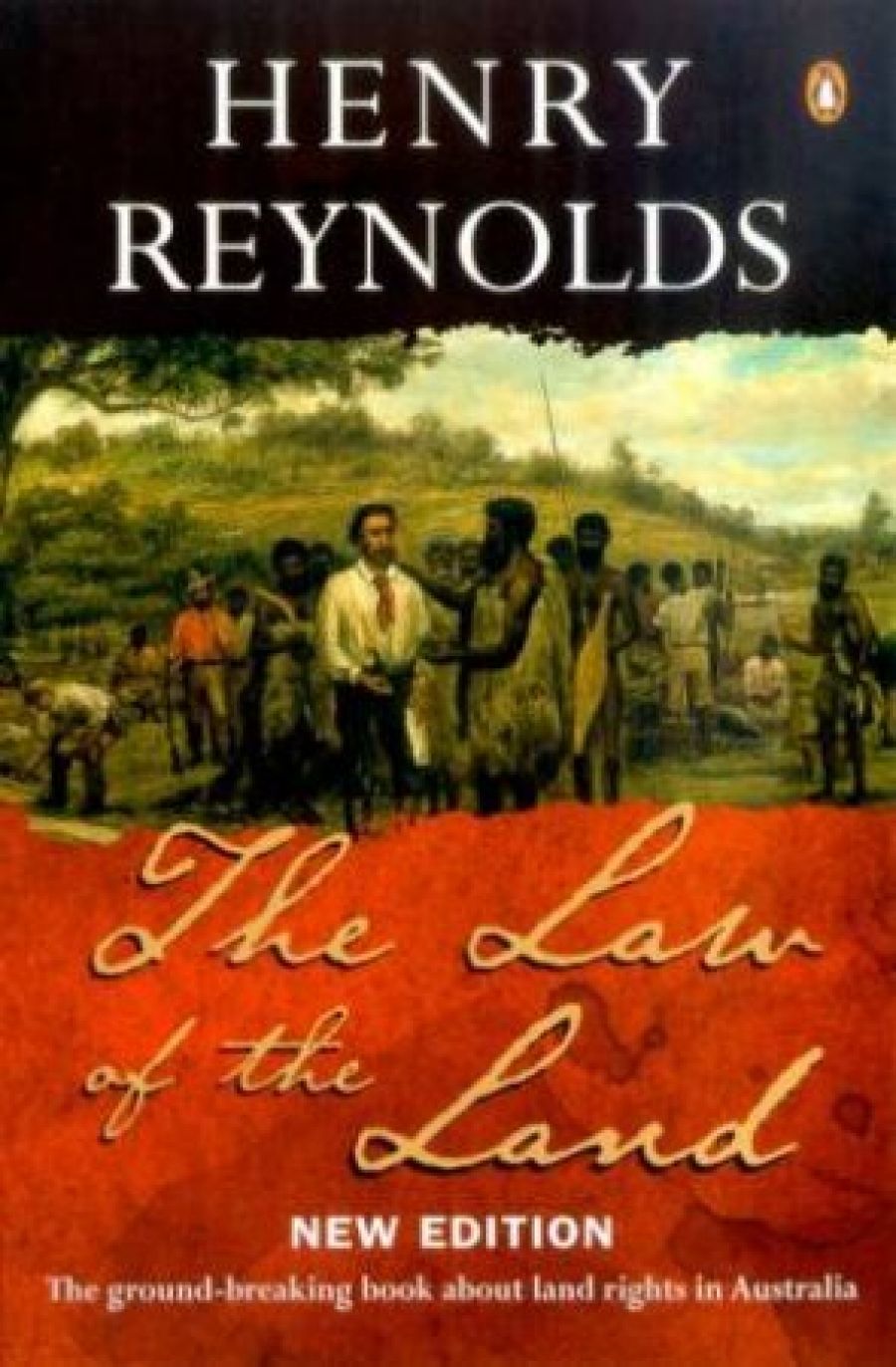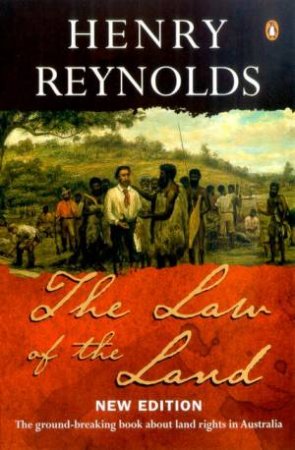
- Free Article: No
- Contents Category: Australian History
- Review Article: Yes
- Online Only: No
- Custom Highlight Text:
The new edition of Henry Reynolds’s acclaimed The Law of The Land is described on its front cover as ‘the ground-breaking book about land rights in Australia’, but ‘the heart-breaking book’ would be more apt. Reynolds has updated his classic text by documenting the progress (or otherwise) of native title since the 1992 Mabo High Court decision. It is not a happy story.
In the book’s first edition, published in 1987, Reynolds advanced the argument that native title rights were recognised – but not properly protected –under British common law in the early nineteenth century. On the frontier, where violence ruled, those legal rights were generally disregarded, but, as Reynolds argued, not necessarily explicitly extinguished. The thesis outlined in The Law of the Land is popularly believed to have been influential in the 1992 Mabo judgement, a perception fuelled in part by Reynolds himself. In the postscript to the book’s second edition, published in 1992, soon after the Mabo decision was handed down, he wrote:
[T]he court had clearly absorbed the lessons about Australian history embodied in the new historiography of European-Aboriginal relations that had been written over the previous twenty years. Law and history now coincided in the view that the Aborigines were not dispossessed in an apocalyptic moment in 1788 but in piecemeal fashion over a long period of time.
- Book 1 Title: The Law of the Land
- Book 1 Subtitle: Third Edition
- Book 1 Biblio: Penguin, $24.95pb, 311pp
- Book 1 Cover Small (400 x 600):

- Book 1 Cover (800 x 1200):

In this most recent edition of the book, the postscript becomes a chapter documenting the Mabo decision and is expanded to include the 1996 Wik decision. Pursuing his theme that these legal decisions, underwritten by historical scholarship, represent the rehabilitation of the law, Reynolds has titled the chapter ‘Mabo and Wik Remake the Law of the Land’. A separate chapter on pastoral leases, comprising mainly old but also some new material, has been included to provide the necessary historical context to the Wik decision, which found that pastoral leases did not automatically extinguish native title. This rearrangement of material underscores Reynolds’s overriding argument that ‘history was the key’ in determining Mabo and Wik. For Reynolds, the legal decisions represent the proper union between law and history, two institutions he believes to be the source of justice and liberation.
If the second edition of The Law of the Land celebrated the marriage of law and history, the third edition documents its disintegration. In the final chapter (the only one with completely new material), Reynolds examines the ‘principal native title cases dealt with by the High Court between 1996 and 2002’ to show ‘the way the principles of native title were evolving’ (or dissolving) in Australia. This case-by-case analysis is used to demonstrate the perceived failure of the Australian legal system to grapple with history or to provide reparation for historical injustice. Reynolds discusses the Yorta Yorta case in Victoria, in which the ‘tide of history’ metaphor was given new life by Justice Olney, but optimism that the native title process might be a source of justice for dispossessed Aborigines in the south-east (or ‘settled’) Australia was proved misplaced. The Yamirr, Ward and Fejo and Mills cases are also covered, providing a testament to indigenous people’s struggle for justice and the litany of disappointment repeated in the courtrooms where they made their claims. This same post-Mabo scene was recently described by former judge Hal Wootten: ‘The shards of the Mabo aspiration lie around us in new case names that threaten to usurp its household status, at least in some Aboriginal communities –Yorta Yorta, de Rose, Ward, Wilson, Yarmirr.’
To explain these ‘shards of Mabo aspiration’, Reynolds employs a disturbing metaphor (or two): ‘Having given birth to native title, the High Court decided to bind its feet before it could develop any jurisprudential strength and mobility.’ This is a particularly telling image (even without reference to its gendered imagery). It makes clear that Reynolds holds the legislators and the lawyers responsible for the mess that is now Mabo. He argues that the principles enshrined in the original Mabo decision have been subsequently interpreted and applied narrowly and grudgingly. As evidence, Reynolds compares the Australian response to native title with other countries, such as New Zealand, the US and Canada, where, he argues, the form of native title recognised by their courts is more robust than that acknowledged by the Australian High Court in key cases. Likewise, he suggests that the processes for dealing with past injustices, such as the Waitangi Tribunal in New Zealand, have been a more effective means for historical reparation. Like Wootten, Reynolds believes that the situation in Australia could have been otherwise had there been the political will to deal with the injustices created by dispossession in ways other than a court-based system; particularly one in which the onus is on indigenous people themselves to prove that their title has not been extinguished. The legal and legalistic route that has been taken in Australia is for Reynolds ‘a great opportunity ... squandered’.
Eddie Mabo has been an increasingly central figure with each new edition of The Law of the Land. In the second edition, Reynolds explained that his research had its origins in conversations between himself and Mabo in the 1970s. The two men can be heard talking again in the closing pages of this book, where Mabo is invoked from beyond the grave. In a short conclusion, Reynolds tells us that as he wrote he often wondered ‘what Eddie Mabo would have thought of the [Mabo] judgment and the subsequent developments’. He imagines that the fact that native title had made more progress in the Torres Strait than anywhere else would have pleased Eddie; the Croker Island decision would have angered him; and the vehemence of opposition to native title would not have surprised him. As his friend, perhaps Reynolds did know Mabo well enough to anticipate his reactions. Yet it is not the substance but the symbolism of remembered and imagined conversations between Reynolds and Mabo that is most significant. Their talk unites them and their cause. At the same time, Reynolds has cast Mabo in the role that he has increasingly come to occupy in an Australian imagination: as conduit for a collective conscience. If Mabo were to be disappointed, but not necessarily surprised, by how things had turned out, then this, Reynolds suggests, ought to be a guide for our own response. Hope remains.
Given that Reynolds’s approach is to update rather than revise, readers get two books in one: the original 1987 scholarship plus the Mabo and post-Mabo analysis. While his original thesis has been criticised by some prominent historians, anthropologists and lawyers, in this new edition Reynolds has eschewed the opportunity to respond to them. That the task was perhaps beyond him is suggested in the preamble to the original introduction: ‘On re-reading the Introduction to the first edition I was immediately struck by how dated it now was, and the question arose as to whether it should be preserved as a historic document; radically rewritten; or deleted altogether.’ Preservation is his preferred option. Readers can therefore approach the book both as historical scholarship and as historical artefact.
The additions to the original text tell a new story. increasingly commonplace, about attempts by settler societies to redress historical injustice without compromising the integrity of their institutions. As such, the lasting value of this most recent and – one suspects, final – edition of The Law of the Land will be as a lesson about what happens when nations like Australia seek to settle their colonial past by employing the same tools they used to colonise in the first place.


Comments powered by CComment